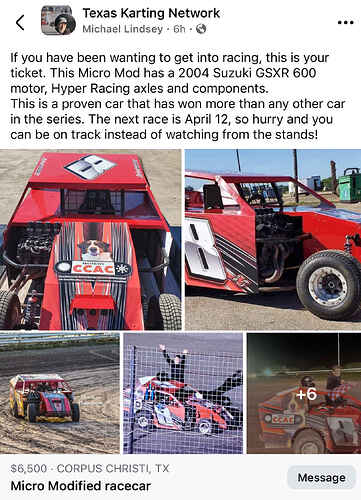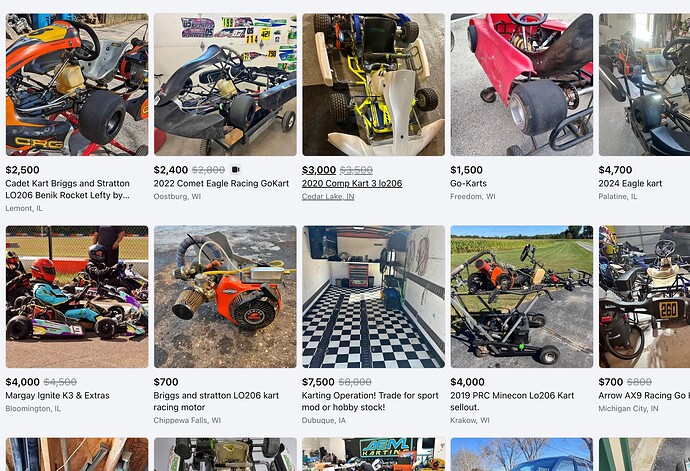Hol up, your “just married” car was a racecar? I can just imagine you guys sending it with cans on a string clattering behind!
Conduit - METAL rollcage. We removed the galvanization with Drano before welding to prevent toxic fumes and poor welds.
Also, a flat rate for inflation isn’t applicable in all cases. When lumber skyrocketed, the cost was likely hyperinflated, but some markets have returned to “normal” pricing while some stay inflated. I have a planbook still, and will be building one of these soon… I’ll be sure to post back real costs. It will be interesting to see which side of your claimed $1200 it falls on.
Karts now cost around $4k, though, so the point still stands.
I wasn’t arguing the point either way, just trying to adjust the math more accurately. While we are all aware of the shortfalls of using CPI for inflation, it is oftentimes better to have a consistent error (single inflation number) than an inconsistent error (personal experience and intuition).
Not so much a racecar since it is a DE car. She won’t let me fully gut it and cage it, so she is a strong advocate of me getting into something like Spec Miata so I don’t risk her baby, haha. Still, SM is around $20k once you buy a good car, a few major spares, and fill the parts fund. Plus, I’ve driven a SM on track before and it was fairly low on fun factor. Kind of like a 206, you don’t buy one because it is thrilling to lap.
Correct - you buy a Spec Piñata for the unknown. You never know when someone’s tires, talent, equipment or patience will expire. Or your own. Kinda like 206. ![]()
Sorry to be noob but what does the DE stand for
HPDE = High Performance Driver Education, DE for short. It is the common term for a generic, noncompetitive track day. They tried for a while to convince insurance companies to not exclude DE events since the driver is getting better at driving, but pretty much all mainstream coverage will deny an on-track incident these days. There are specialty companies (like Haggerty) that will offer track-only coverage, but the terms are pretty steep. Deductibles are very high, premiums are around the cost of entry for the event, and you can get dropped easily if you use it. So, even with coverage, an accident can cost a few thousand dollars, and even not having an accident can cost a couple thousand in premiums per year. This is just for noncompetitive driving, so karting compares very favorably when you look at costs.
Miraculously, standard insurance covered this incident 12 years ago (but I’m no longer allowed to be a customer of theirs, haha), and the total came out close to $20,000:
“High Performance Driving Event”, run with or without education and/or instructors on-board depending on the org of choice and variety of car types involved. Typically involves strict rules about passing and top speed limits vary by car type and division of driver skill.
For what it’s worth, I’ve seen some of the most dangerous wrecks at these types of events because liberties are taken with personal safety in non-race-prepped cars. Up to and including fatalities.
But there have been recent karting fatalities also, so never take safety in motorsports for granted.
Track days are another entry-level motorsport activity for many people, but I think Karting compares very favorably them.
- HPDE entry fees are often $150 - $300
- Insurance as you said often doubles the entry cost.
- Wear on brakes and tires is considerable if you participate regularly.
- A set of track-specific wheels and tires will cost a few thousand to get into.
- Risk is high. Even if you’re insured, repairing/replacing a road car sucks and is disruptive to your life.
My per-day cost of Lo206 is cheaper, and I get to actually race wheel-to-wheel instead of just hotlapping!
Autocross IS cheaper than karting as an entry-level motorsport to just show up and participate in, but if you want to be competitive it’s a separate set of wheels and tires at minimum. It quickly blows club karting out the water if you want to build a car for any of the non-street classes.
Club karting doesn’t have the same visibility as these activities and car guys will likely gravitate to driving their own cars in these events first.
Nooooo not the Lotus! ![]()
Thanks for the explainers… never done any HPDE stuff.
The most potentially expensive (and dangerous) part of HPDE running comes from the wide range of potential vehicle performance coupled with the wide range of driving experience.
Most HPDE days break their participants into run groups based on skill & experience level, rather than pure vehicle performance, so you’ll get a breakdown of something like:
A-Group: High skill drivers that don’t need ride-alongs and instructors running their own cars (open passing)
B-Group: skilled drivers, optional ride-along instructors (mostly passing allowed only by point-by)
C-Group: newer drivers, mandatory ride-along instructors (passing by point-by, only on designated straights)
The situation I would run into is that after a decade of karting, when i started HPDE I was comfortable enough to routinely run in a “B-Group” without much instruction, but if you’re not an HPDE die-hard, and just running a modest daily driver on Ultra-High Performance Summer tires (in my case, a stock Scion FR-S with performance pads and rotors for the track) you can find yourself in a run group full of much less experienced “dentists and lawyers” with popular track day Corvettes and Porsches that are much more capable but whose drivers have lot less “track awareness.'”
Being caught in a low-hp car in a run group full of high-hp but lower experience drivers causes you to focus far more on watching out for potential accidents than getting to focus on improving your own driving and laptimes.
From the rental track at NJMP you get to see the presumably HPDE folks go by on the car track. There’s occasionally a plume of smoke so I can imagine that things get messy out there!
I used to have an Elise. Awesome car but man was body damage expensive. I was parked at work and a lady with no driver license was driving her husband’s commercial work van and backed up into my Elise. She tried to drive away and thankfully my boss happened to see it and stopped her. She barely hit my car but it was enough to put a big crack in the fiberglass clamshell. Basically the whole rear fenders and bumper are one handmade piece of fiberglass called a clamshell. The husband showed up and was asking if he could just pay for the damage without calling insurance, since his wife didn’t have a license. I told him replacing the clamshell will be like $10,000 to $15,000. He looked like he was going to pass out. It ended up costing closer to $20,000, just for a bump that wouldn’t have put a dent in my truck bumper.
Blockquote
And congrats on having a wife that seems to like the Elise. My then girlfriend, now wife, hated driving it. She was too afraid of crashing it to enjoy.
Yep, my car is green now thanks to a Tesla driver who thought all the loud beeps were a weird radio station or something.
He even swore he didn’t back into me because it didn’t damage his bumper, so I had to explain that Lotus had Federal exemptions for the lack of 5mph bumpers. Even going through the grass on a track day could be five figures if I hit a particularly tough anthill. Thankfully I used that last insurance claim to fund my own fiberglass education and figured out how to do it myself, but the time alone is substantial.
Mine has been crashed enough times, I think I’ve just acclimated to it. Still, the idea of just using a mallet to hammer out a dent is strongly appealing, so I occasionally shop for a track-only car.
Karting last year was much more expensive than I had expected, and that really got to me. Still, compared to cars, it wasn’t bad at all, just worse than I had naively expected. Setting bad expectations can do that. This year I have better expectations, so I’ve vowed to not let surprise costs bother me. They are just the costs of doing business.
When I put the Elise into that guardrail, a friend said “education is expense”, and that’s a great mentality that’s helped a lot. Sometimes we learn how not to execute a pass, and that instructor is not for free.
(New) Karting Prices Analysed (1990-2021)
Manufacturing advancements and lower labor costs have made many luxuries more affordable. However, when comparing karting and racing costs from the 1990s to today—adjusted for inflation—racing was generally cheaper in the past (See link).
Some cost increases are justified by user-friendly advancements, such as onboard starters, longer rebuild cycles, and improved chassis. Similar trends exist in electronics; for example, while you can purchase a TCL Smart TV at Walmart for $100, high-end models like a top-of-the-line Samsung can cost $3,000. However, the average consumer typically opts for the more affordable option in $400-$500.
The VR1 and Voodoo karts, priced between $1,200 and $2,700, are comparable in price to the Jeta W/Solo local option setup from the 1990s, according to historical pricing. While the VR1/Voodoo may not be the high-end equivalent of a Samsung TV, it aligns more closely with a TCL model. Though these karts are often criticized for poor construction, their price points make that understandable. Still, are they any less reliable than the budget-friendly options available in karting from the 1970s to the 1990s? I have never seen VR1/Voodoo on track before, typically a used kart is the same price point.
But that’s not apples to apples. Go look at used karts with 20 year old engines to compare. I searched “LO206 kart” on Marketplace and found dozens upon dozens of complete karts $3k or under that are only a couple seasons old.
I hear this a lot from people. “For the money I’m spending on karting, I could go race cars!” But when people say that, they are usually talking about racing beater street stocks or something at the local dirt track vs. national level karting, which are two totally different levels of the sport. Compare national level dirt racing to national level kart racing and the gap in financial requirements becomes uh… enormous.
I get the sentiment though.
I absolutely agree, TJ. However, one could argue local level mini modifieds or “street stocks” or late models or whatever it is called near you is still a step “up” from kart racing.
I know I would have a heck of a lot of fun racing sprints or modifieds at only local tracks. However, compared to my kart budget (which is tiny compared to most folks), it is still a lot of money.
We could be having this same conversation about Lemons racing or something similar on asphalt. Again, it looks cheap, but ends up being pretty expensive, as well.
You raise a good point, which is that life itself has finally priced out the average person.



